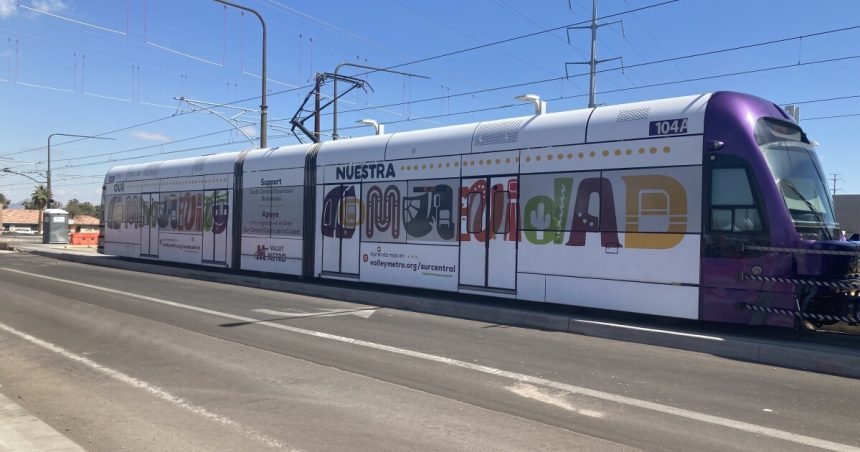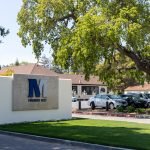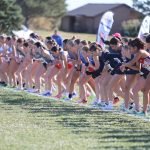The 5-and-a-half mile south Phoenix extension of the light rail has been controversial from the start.
Local businesses along south Central Avenue protested — they wanted the street to remain four lanes, they didn’t want to suffer through years of construction, and they wanted a bigger say in the process.
Well, despite those efforts to stop it, the extension has now been built. It opened earlier this summer.
So how are folks adapting? One south Phoenix resident and Substacker to hear about his experience along the new rail line — and his impressions of the controversy.
Billy Robb is a teacher in the Valley who writes the Cholla Express substack. The Show spoke with him more about it.
Full conversation
LAUREN GILGER: I want to start with your initial impressions of this because you live in south Phoenix and it sounds like the new extension of this light rail is pretty close to home to you, but literally close to home to you, right?
BILLY ROBB: Yes. I’ve been working in south Phoenix for about 10 years and living there for five years. So I’ve been paying attention to the conversation from the beginning about the light rail proposal to go down to, to south Phoenix and watching the news. And then the last five years seeing the construction start and seeing it develop and now brought to completion. And so I wanted to get a little overview of the entire project and also experience it for myself and ride it a couple times and write about the experience.
GILGER: Yeah, so we’ll get to that. It sounds like you were, especially because you’re near it, maybe a little initially skeptical of the need for light rail here in the Valley. Why?
ROBB: Yes. And that was also the impression of a lot of the residents and especially the business owners that lived along Central Avenue, mostly because Central Avenue was kind of the main artery, the main thoroughfare through south Phoenix, you know, four lanes. There was lots of businesses that have been there for a long time along that road.
And just the nature of the light rail in general, which is it’s, in Phoenix, it’s slower than subways or elevated trains in other cities because it runs alongside the traffic. So it’s just, it doesn’t have the, the feel of being an exciting, necessary project that, that people are going to jump on, give up their cars and feel like they can, they can get anywhere they want more quickly than options that already exist like the bus.
GILGER: And as you said, it’s been controversial kind of from the beginning where we’re a very car-centric town. But I wonder what you make of the south Phoenix extension in particular. Because if you’re talking about the main argument for extending the light rail to south Phoenix. It’s, it’s revitalization, right, like of neighborhoods of investment in south Phoenix, which has historically been, what’s the word, I guess they say, underserved, right?
ROBB: Yes. Me personally, I’ve never been a partisan or an activist on this issue. I’m more of a, you know, a resident and observer of all this. So, yes, the pro light rail argument is that, you know, it will create a vital connection that allows people not only to live in South Phoenix and work in downtown without a car, but also hopefully encourage people from central Phoenix and other parts of the Valley to go visit downtown as well, which might be a plus for businesses there.
But the con arguments is just that it’s hurting the people that have businesses on Central Avenue, south Central Avenue. They’ve been there for a long time. So it’s the community itself and the people that live there, they didn’t seem to want it. And there is, there is some great reporting in the AZ Mirror, which said that the only two precincts in the entire city actually approved a measure that would have stopped light rail. And those were the precincts that were, that were the closest in south Phoenix.

GILGER: So I mean, it’s sort of ironic, right, because this was the city of Phoenix saying, we want to invest in you, south Phoenix, which is this historically more low income, you know, more people of color, kind of part of town that’s always, as you said, been kind of divided south Phoenix from the rest of the city.
And the people there saying, we don’t want this investment.
ROBB: Right. And so it’s, you know, it’s from a, from a bird’s eye view, you can, you can look at it and say, it’d be good for south Phoenix, it’d be good for Phoenix as a whole to have this light rail connection. It was kind of cool. It’s a light rail. Other other big cities have mass transit, light rail, subways, and this is, and this is ours and we should connect it.
But there was from the very beginning complaints about being left out of the process. And another point in time where there was a demand for the four lanes. There was a group that started that said four lanes or no train. And they were, and they were trying to pause the project in order to try to reevaluate the maps and try to see if we can keep four lanes.
But the main thing that, that stopped that was that we had federal money coming in and the federal grants were sort of time sensitive. So there was a concern for the pro transit people that, you know, if you, if we had delayed this, we might lose the federal funding. We might not be able to get this project built at all.
GILGER: So, Billy, now that the extension has been completed, there was a, you know, a big unveiling ceremony. Everyone’s there and, and cheering for the project.
How are businesses, how are residents like you in south Phoenix feeling about it?
ROBB: Well, I thought it was interesting and I was looking forward to riding it. I wrote about a Fox 10, they went and interviewed some, some businesses along the south Central corridor. This was very close after it got finished.
And there was still some frustrations there, mostly because traffic for these businesses depends heavily on, on traffic and random, sometimes random stops or people driving back and forth. And it’s, and it’s, not only is it two lanes, one lane each way, but you can’t turn left anymore into the businesses. You have to wait till the intersection and either take a U-turn or take a left and then try to get through the other side.
And there hasn’t been yet the, you know, the new, I think there will be new housing projects built along Central Avenue. So that will come eventually, I think, and the, and the area will develop around it because of that. But I don’t think it has happened yet. And I think the traffic patterns will probably be always lower than it was before.
GILGER: So you tested it out, as you said, you, you rode it a couple of times. How’d it go?
ROBB: The first experience I wrote about was negative. The train was significantly late, like 20-25 minutes late. A couple people that had their Diamondbacks jerseys on actually walked away.
And then on the train, I write about how I did see a visibly intoxicated passenger that, that was making, making kind of a scene and started an argument. I was, I was worried for a minute that there was going to be a physical fight, and I was trying to think about what I was going to do about it.
But I did, since I was going to write about it, I wanted to not just have one experience. So in the subsequent times that I took it, it was great.
GILGER: Let me end with one final point that you make in your piece about this, Billy, which is that this all makes you think about a different kind of future of transportation, right?
Like the self-driving taxi and car world, which is already here and, and sounds like you think will be our actual replacement for cars in the Valley.
ROBB: Yes, I think so. I think it can be a complement to public transportation. There was news out in Chandler that they are contracting with self-driving taxi service to sort of use it as a low cost replacement for maybe a bus or another transit service.
That’s another opportunity of, you know, the city contracting with self-driving taxis to solve, you know, some of the gaps that might be there in terms of people that don’t have cars that use public transportation or that might be if there’s more self-driving cars or cheaper options out there, might be enticed to give up their vehicles.











